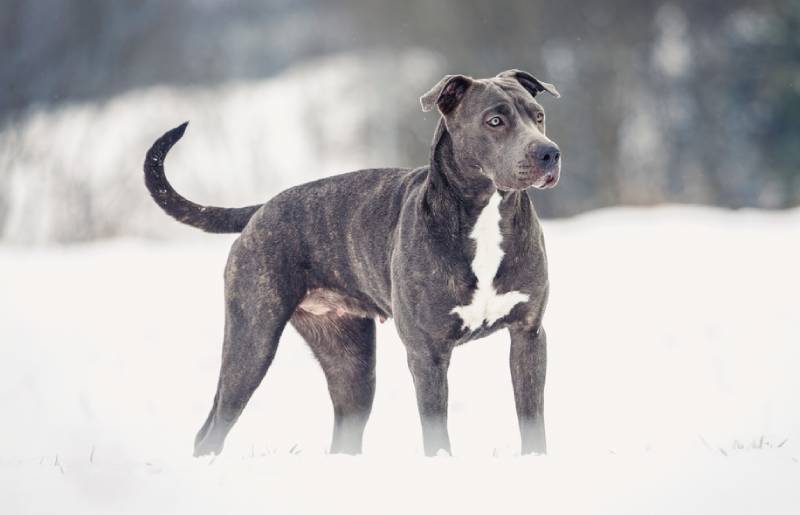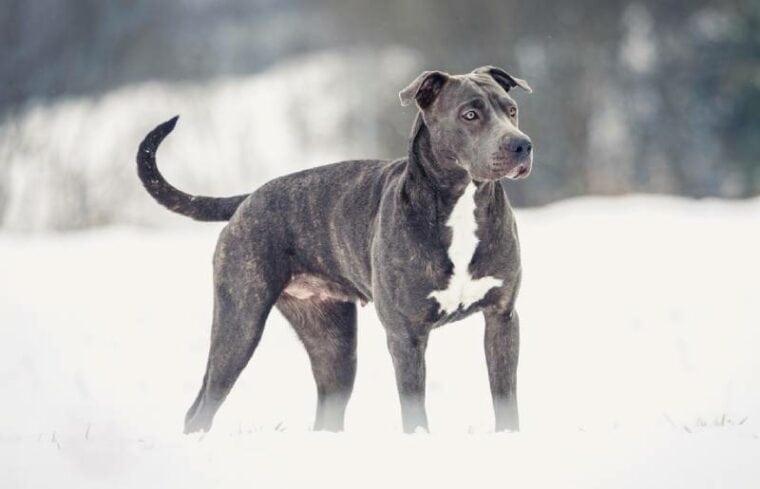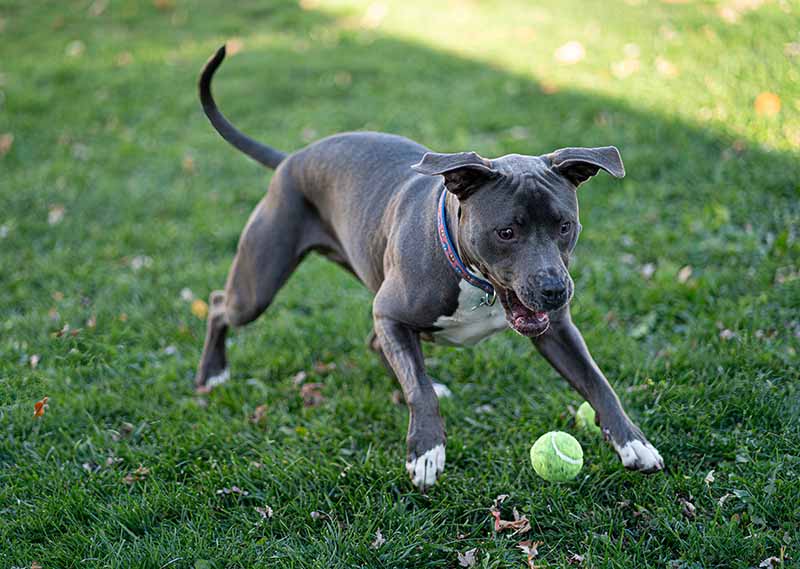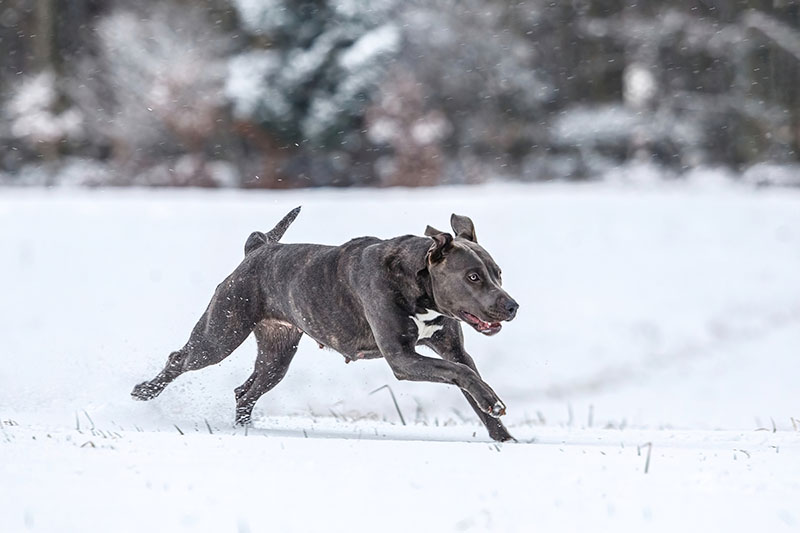- May 17, 2023
Grey Pitbull: Facts, Origin & History (with Pictures)


Pitbulls come in different colors, one of the rarest being grey. Grey Pitbulls are not a particular dog breed but any Pitbull with the recessive gene responsible for the dilution of the black color variation.
Like regular Pitbulls, grey Pitbulls are athletic, agile, and fun. They make excellent family pets for their affection, loyalty, and gentleness. Does the grey Pitbull pique your interest? Read on to learn about its history, breed profile, care needs, and more!
Breed Overview
Colors:
Grey, charcoal, blue-grey, silver-blue
Suitable for:
Experienced pet parents that can provide consistent and firm training and socialization
Temperament:
Loyal, gentle, loving, eager to please, excellent with kids, and gets along with other pets, just not smaller ones
Grey Pitbulls occur when a puppy inherits the dilute gene from both parents. The only difference between them and regular Pitbulls is their grey coats, eyes, noses, and toenails, which give them a distinctive appearance.
The recessive gene alters normal pigmentation and makes the dominant black hue appear more dilute. What happens is that each follicle gets more pigment around the center and none at the tips. This rare combination creates an optical illusion that makes the dog appear grey, charcoal, blue-grey, or silver-blue.
Breeding grey Pitbulls is challenging because both parents must have a recessive gene. Most breeders only own a small gene pool that can only produce as many healthy litters. Excessive inbreeding is dangerous and can lead to health issues like immune and nervous system dysfunctions.
Grey Pitbull Characteristics
Energy:
+
High-energy dogs will need a lot of mental and physical stimulation to stay happy and healthy, while low-energy dogs require minimal physical activity. It’s important when choosing a dog to make sure their energy levels match your lifestyle or vice versa.
Trainability:
+
Easy-to-train dogs are more skilled at learning prompts and actions quickly with minimal training. Dogs that are harder to train will require a bit more patience and practice.
Health:
+
Some dog breeds are prone to certain genetic health problems, and some more than others. This doesn’t mean that every dog will have these issues, but they have an increased risk, so it’s important to understand and prepare for any additional needs they may require.
Lifespan:
+
Some breeds, due to their size or their breeds potential genetic health issues, have shorter lifespans than others. Proper exercise, nutrition, and hygiene also play an important role in the lifespan of your pet.
Sociability:
+
Some dog breeds are more social than others, both towards humans and other dogs. More social dogs have a tendency to run up to strangers for pets and scratches, while less social dogs shy away and are more cautious, even potentially aggressive. No matter the breed, it’s important to socialize your dog and expose them to lots of different situations.
The Earliest Records of Grey Pitbulls in History
Pitbulls have been around since the early 1800s. They have a long and fascinating history, and the grey varieties just happen to be a rare breed variation. Their origin can be traced back to the United Kingdom, where they were bred from Old English Bulldogs.
At first, they were bred for entertainment and participated in a cruel blood sport called bull and bear baiting. This sport was banned in 1835 following the enactment of the Cruelty to Animals Act.
Now that bulls and bears could not participate in pit fights, the public turned to pit the dogs against rats before they gained interest in dog fights. Crossbreeding the Old English bulldogs with breeds like Terriers brought rise to breeds like the Pit Bull Terrier, which is just as strong and tough but more agile and fast.
It was not until 1976 that Congress amended the Animal Welfare Act also to ban dog fighting. From this point, Pitbulls were converted to farm work dogs before they were accepted as the cuddly furry friends we know today.

How Grey Pitbulls Gained Popularity
Pitbulls have always had a controversial reputation because of their days of pit fighting. However, handlers also wanted to be able to separate the fighting dogs without suffering injuries. As part of their genetic makeup, grey Pitbulls are not prone to biting humans.
Pitbulls gained popularity after pit fighting was no longer a thing. This made people see their other side, which was gentle, sensitive, and friendly. As the fear for the breed receded, it became better known for its strength, agility, and caring nature.
Formal Recognition of Grey Pitbulls
The four Pitbull breeds include the following:
The AKC recognizes grey Pitbulls from Staffordshire Bull Terrier and American Staffordshire Terrier breeds. On the other hand, the UKC only approves of grey variations of the dog from American Bully, American Pitbull Terrier, and Staffordshire Bull Terrier breeds.
Top 3 Unique Facts About Grey Pitbulls
Grey Pitbulls have a pleasant demeanor and make great pets for therapeutic support. They consider themselves fully-fledged family members and even become overly clingy to their owners.
Here are three unique facts you should know about these dogs.
1. The Rare Coloration Attracts a Steeper Price Tag
Grey Pitbulls are extremely rare and in high demand. Reputable dealers who are lucky to have puppies from reliable bloodlines will sell them for as much as $10,000.
The initial cost of setting up the pup in your home is around $2,000, which includes food, licensing, desexing, and vet bills for preventative care. One of the surest ways to keep expenses manageable and protect yourself from unexpected vet bills is to invest in proper pet insurance coverage.
2. Puppies Are Born With Bright Blue Eyes
Grey Pitbull puppies have bright blue eyes, which may come as a surprise to a new pet parent. The lack of melanin in their eyes causes this unique coloration. Although some dogs retain this eye coloring, most don’t.
The eye color of most grey Pitbulls begins to darken gradually after the first few weeks of life. By the time the pup is nine to sixteen weeks old, the eye color will have permanently set into a light grey/ blue hue. Grey Pitbulls can also have hazel, dark brown, or light brown eyes.

3. Training Reduces Aggressive Tendencies
Unfortunately, Pitbulls still have an air of terror around them.
Most people get the picture of an aggressive and bloodthirsty dog at the mention of the breed. Although the predecessors of these dogs were bred for a cruel sport and fought to the death in pits, their aggressiveness was primarily caused by the inhumane treatment they received.
Pitbulls don’t have an aggressive gene.
When pampered with love, they find no need to use their muscle or jaw power for self-defense. Instead, they mimic the warm owner-pet relationship they receive and can even babysit without supervision.
According to ASPCA’s stance, grey Pitbulls maintain a happy-go-lucky demeanor with proper training and socialization. They are sweet, affectionate, and highly sociable, even towards strangers.
Do Grey Pitbulls Make Good Pets?
Grey Pitbulls are great pets and, even better, jogging and running companions.
They are sweet, sensitive souls that make excellent nanny dogs because of their stable temperament. With proper training and socialization, they remain calm, friendly, and welcoming even to new faces.
Still, they make exceptional guard dogs for being extremely loyal and protective of their family members.
The grey Pitbull is a superb choice if you are looking for a guard dog. Its stocky and muscular body can scare the living daylights out of any intruder. This also means you must have the time to train your dog and engage it in daily exercise to reduce pent-up energy and its potential for aggression.
Generally, grey Pitbulls make excellent pets for active families that can provide much-needed mental and physical stimulation.
Although they are house dogs that should not be locked outside, their energy levels make them unsuitable for apartment living. They are happier and healthier within environments where they can run around and act busy.
Final Thoughts
Pitbulls, in general, have a bad history of aggression. However, when properly trained and socialized, they make some of the most adorable family pets. Grey Pitbulls are no exception and are best suited to experienced pet parents that can keep their wild side well-managed.
So, should you add a grey Pitbull to your household if you have kids? Absolutely!
Grey Pitbulls, irrespective of breed, have one of the most stable temperaments, just like golden retrievers. They score high on “canine good citizen tests” and are people-friendly, kid-tolerant, and easy-going with other family pets. Again, the secret is to provide proper training and socialization.
Featured Image Credit: Annabell Gsoedl, Shutterstock
Tags
What do you think?
Related Articles

New Puppy Checklist: Gear You’ll Need for Your New Dog
Getting a new puppy is really exciting, but before you welcome them home, it’s important to prepare your space for them. Since puppies need a

How Big Do Mini Poodles Get? Vet Reviewed Average Weight & Growth Chart – Dogster
The information is current and up-to-date in accordance with the latest veterinarian research. Learn more » When you buy a Miniature Poodle, you might not

Can Police Dogs Smell Nicotine? Vet Verified Facts & Info – Dogster
The information is current and up-to-date in accordance with the latest veterinarian research. Learn more » While cigarette sales have been declining steadily for decades,

How Old Is 5 in Dog Years? Vet-Approved Guide to Each Size of Dog – Dogster
The information is current and up-to-date in accordance with the latest veterinarian research. Learn more » A common method for calculating a dog’s age is




